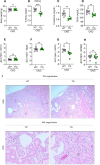This is a preprint.
Transgenic augmentation of erythroferrone in mice ameliorates anemia in adenine-induced chronic kidney disease
- PMID: 39713359
- PMCID: PMC11661078
- DOI: 10.1101/2024.12.06.627111
Transgenic augmentation of erythroferrone in mice ameliorates anemia in adenine-induced chronic kidney disease
Update in
-
Transgenic augmentation of erythroferrone in mice ameliorates anemia in adenine-induced chronic kidney disease.JCI Insight. 2025 Aug 7;10(18):e190018. doi: 10.1172/jci.insight.190018. eCollection 2025 Sep 23. JCI Insight. 2025. PMID: 40773297 Free PMC article.
Abstract
Anemia is a common and disabling complication of chronic kidney disease (CKD). Current therapies can be burdensome, and full correction of anemia is limited by cardiovascular side effects. New approaches that may offer additional therapeutic options are needed. We explored the anti-anemic effects of erythroferrone, an erythroid hormone that induces iron mobilization by suppressing the master iron-regulatory hormone hepcidin. In a preclinical murine model of adenine-induced CKD, transgenic augmentation of erythroferrone mobilized iron, increased hemoglobin concentrations by approximately 2 g/dl, and modestly improved renal function without affecting systemic or renal inflammation, fibrosis, or markers of mineral metabolism. This study supports the concept that therapeutic augmentation of erythroferrone is a promising approach for alleviating CKD-associated anemia.
Conflict of interest statement
Conflicts of Interest TG and EN are shareholders and scientific advisors of Intrinsic LifeSciences, and consultants for Ionis Pharmaceuticals, Disc Medicine, Chugai and Vifor. EN is a consultant for Protagonist, TG is a consultant for Silence Therapeutics, Dexcel and Avidity Bio. Other authors declare that they have no conflicts of interest with the contents of this article.
Figures









References
-
- CDC. Chronic Kidney Disease in the United States, 2023. Atlanta, GA: US Department of Health and Human Services; 2023.
-
- Macdougall IC. Anaemia in CKD—treatment standard. Nephrology Dialysis Transplantation. 2023;39(5):770–7. - PubMed
-
- Fishbane S, Ross DW, and Hong S. Anemia in Non–Dialysis-Dependent CKD: To Treat or Not to Treat? Am J Kidney Dis. 2019;73(3):297–9. - PubMed
Publication types
Grants and funding
LinkOut - more resources
Full Text Sources
